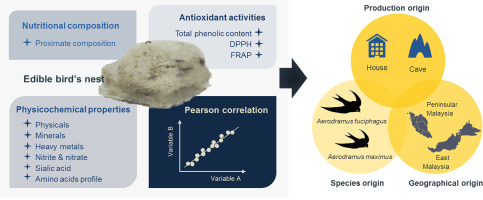Food Research International ( IF 7.0 ) Pub Date : 2018-03-31 , DOI: 10.1016/j.foodres.2018.03.078 Meei Chien Quek , Nyuk Ling Chin , Yus Aniza Yusof , Chung Lim Law , Sheau Wei Tan

|
Edible bird's nest (EBN) is a precious food made from the solidified saliva of swiftlets. EBN from three types of origin, namely production, swiftlet species and geographical were characterised based on its nutritional composition, physicochemical properties and antioxidant properties. Proximate composition, total phenolic content (TPC) and antioxidant activities were determined following official methods, while mineral and heavy metal contents were obtained by respective atomic adsorption spectrometry (AAS) and inductively coupled plasma-mass spectrometry (ICP-MS). Amino acids profile and sialic acid were determined using high performance liquid chromatography (HPLC). Calcium and sodium were the major elements in EBN samples at averages of 17,267 mg/kg and 13,681 mg/kg, respectively. Despite protein contents were not significantly different; interestingly the total amino acids in A. fuciphagus EBN, 64.57 g/100 g was found to be 23% higher than in A. maximus EBN. EBN from house, A. fuciphagus and Peninsular Malaysia had greater antioxidant activities, 2.33–3.49 mg AAE/g and higher sialic acid, 13.57 g/100 g while those from cave, A. maximus and East Malaysia contained more minerals like calcium and magnesium. The 1, 1-diphenyl-2-picrylhydrazyl (DPPH) free radical scavenging activity and ferric ion reducing antioxidant power (FRAP) of house, A. fuciphagus and Peninsular Malaysia EBNs were approximately 2 times greater than the others. All samples were complied with the Malaysian Standard MS 2334:2011, except for mercury and nitrite. The overall findings suggest that the quality of EBN was varied following the production, species and geographical origins.
中文翻译:

利用营养成分,理化特性和抗氧化活性表征不同产量,物种和地理起源的可食用燕窝
食用燕窝(EBN)是由金丝燕的凝固唾液制成的珍贵食品。根据其营养成分,理化特性和抗氧化特性,对来自三种产地的EBN进行了表征,即生产,金丝雀种类和地理区域。按照官方方法确定其近成分,总酚含量(TPC)和抗氧化活性,而矿物和重金属含量分别通过原子吸收光谱法(AAS)和电感耦合等离子体质谱法(ICP-MS)获得。使用高效液相色谱法(HPLC)测定氨基酸谱和唾液酸。钙和钠是EBN样品中的主要元素,平均分别为17,267 mg / kg和13,681 mg / kg。尽管蛋白质含量没有显着差异。结果发现,犬曲霉EBN的含量为64.57 g / 100 g,比最大曲霉EBN的含量高23%。来自房屋,A。fuciphagus和马来西亚半岛的EBN具有更高的抗氧化活性,为2.33–3.49 mg AAE / g和更高的唾液酸,为13.57 g / 100 g,而来自洞穴,A。maximus和East Malaysia的EBN含有更多的矿物质,例如钙和镁。家蝇A. fuciphagus的1,1-二苯基-2-吡啶并肼基(DPPH)清除自由基的活性和降低三价铁离子的抗氧化能力(FRAP)马来西亚半岛的EBN大约是其他国家的2倍。除汞和亚硝酸盐外,所有样品均符合马来西亚标准MS 2334:2011。总体发现表明,EBN的质量随生产,种类和地理起源而变化。











































 京公网安备 11010802027423号
京公网安备 11010802027423号